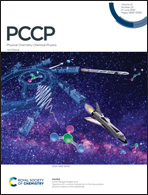Dissociative electron transfer of copper(ii) complexes of glycyl(glycyl/alanyl)tryptophan in vacuo: IRMPD action spectroscopy provides evidence of transition from zwitterionic to non-zwitterionic peptide structures†
Abstract
We report herein the first detailed study of the mechanism of redox reactions occurring during the gas-phase dissociative electron transfer of prototypical ternary [CuII(dien)M]˙2+ complexes (M, peptide). The two final products are (i) the oxidized non-zwitterionic π-centered [M]˙+ species with both the charge and spin densities delocalized over the indole ring of the tryptophan residue and with a C-terminal COOH group intact, and (ii) the complementary ion [CuI(dien)]+. Infrared multiple photon dissociation (IRMPD) action spectroscopy and low-energy collision-induced dissociation (CID) experiments, in conjunction with density functional theory (DFT) calculations, revealed the structural details of the mass-isolated precursor and product cations. Our experimental and theoretical results indicate that the doubly positively charged precursor [CuII(dien)M]˙2+ features electrostatic coordination through the anionic carboxylate end of the zwitterionic M moiety. An additional interaction exists between the indole ring of the tryptophan residue and one of the primary amino groups of the dien ligand; the DFT calculations provided the structures of the precursor ion, intermediates, and products, and enabled us to keep track of the locations of the charge and unpaired electron. The dissociative one-electron transfer reaction is initiated by a gradual transition of the M tripeptide from the zwitterionic form in [CuII(dien)M]˙2+ to the non-zwitterionic M intermediate, through a cascade of conformational changes and proton transfers. In the next step, the highest energy intermediate is formed; here, the copper center is 5-coordinate with coordination from both the carboxylic acid group and the indole ring. A subsequent switch back to 4-coordination to an intermediate IM1, where attachment to GGW occurs through the indole ring only, creates the structure that ultimately undergoes dissociation.



 Please wait while we load your content...
Please wait while we load your content...